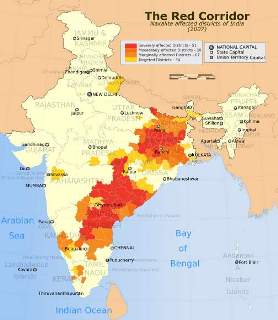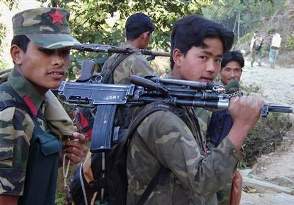|
Grass Roots Military - India's Naxalites/Maoists
by Neeta Lal via baba - Asia Times Sunday, May 13 2012, 10:49am
international /
social/political /
other press
India's Maoists are no rag-tag rebels
NEW DELHI - As India's Maoists continue to strike terror into the hearts of civilians by looting and kidnapping with impunity - they are now estimated to control a staggering one-third of the country's districts - more disquieting facts about their modus operandi have recently come to light.

Red Corridor
According to the latest interrogations of arrested top Maoist leaders by Indian intelligence, the rebels have succeeded in raising a army in their own right in the heart of the country which is fortified with AK-47 assault rifles and an array of other deadly weapons and arms.
The strategy employed by the rebels in building their army indicates that they are a much deadlier adversary than was previously thought. Conversant with techniques of modern warfare, this force is far from a ragtag bunch of confused soldiers inhabiting swathes of jungle.
New intelligence reports have revealed that the Maoist army has three components: the main force, a secondary force and a base force.
The main force - armed with ammunition looted mostly from security forces - has companies, platoons and special action teams besides an intelligence unit. The secondary force comprises special guerilla squads, while the base force is made up of the jan militia. The lower-most Maoist cadre use double-barrel and single-barrel guns, homemade weapons and claymore landmines to blow up vehicles.
The government has now officially pegged the figure of the armed cadres at a staggering 46,600. Of these, the hardcore Maoists number around 8,600 while the jan militia numbers around 38,000, with the latter carrying rudimentary arms and providing logistics support to the core group of the People Liberation Guerilla Army of the CPI (Maoist).
Prime Minister Manmohan Singh has described the Maoist insurgency as "the biggest internal security challenge since Independence", and there is believed to be a "red corridor" stretching from the southern state of Andhra Pradesh to the central state of Chhattisgarh and into West Bengal, bordering Nepal and Bhutan.
The insurgents started their armed struggle in 1967 with a peasant revolt in Naxalbari village in West Bengal, hence the oft-used moniker of the "Naxals".
Regrouping in the 1980s, the group recruited thousands of impoverished villagers and armed them with rifles snatched from police; the Maoist cause resonates among India's oppressed and poor that enjoy little, if any, benefit from India's socio-economic progress.
However, the Naxals have been charged with running an extortion economy under the garb of a popular revolution. They extract enormous sums of money from mining companies, police say. According to a Reuters report, the rebels extort about US$300 million from companies in India every year to fund their movement.
As enlightening as new facts about the Maoists are, it is intriguing why the government has chosen now to release details of the Maoist army and its militia. After all, this disclosure underscores the Maoists' strength and their acumen while highlighting the government's continued failure to control them?
Many feel the disclosures will help the agencies better understand their puzzling adversary, as it seems their appeal cannot be diminished by slogans of development and governance alone. Also, as a newspaper editorial put it, the information reveals that the Maoists are working to ensure the state cannot bring the benefits of democratic governance to the vast tracts they control through fear.
Ministry figures reveal that to battle the Maoists, the government has had to deploy 94,000 paramilitary personnel in nine states. In addition, nearly 100,000 policemen are tackling the Naxals in Chhattisgarh and Jharkhand - two of the worst-hit states. Over 78 battalions of the Central Reserve Police Force, Border Security Force, Sashastra Seema Bal and Indo-Tibetan Border Police are stationed in other states to fight the Naxal terror.
Despite the heavy investment of financial and military resources, the Naxals have succeeded in killing 483 security men while losing only 286 from their own cadre since 2010. "The Maoists continue to have an edge because of the topography of their hideouts in deep forests," revealed Minister of State in the Home Ministry Jitendra Singh in a written reply to the Lok Sabha (lower house) this week.
There is increasing concern in the security establishment over the dramatic upward spiral in the fatalities of the security forces at the hands of the Maoists. Ultras killed 52 security personnel in the first three months of this year until March 31. The CPI (Maoist) - spearheading the Naxal violence across the country - accounts for 95% of the incidents perpetrated by the Maoists in the affected states.
Alarmingly, from traditional guerrilla hit-and-run tactics, the Naxals have moved seamlessly to terror tactics of kidnap and ransom.
Last month, a group of 15 extremists, disguised as villagers, kidnapped a 32-year-old official in Chhattisgarh's Sukma district. As his pregnant wife pleaded for mercy and asked the government to ensure his safe release, the Maoists radioed to a reporter a list of five demands for his freedom that included the release of many Naxal leaders.
This incident was part of a series of abductions that the Maoists have engineered over the past two years in Chhattisgarh and neighboring Orissa.
Their first major success was Malkangiri district collector R Vineel Krishna in Orissa in February last year, followed by two Italians and politician Jhina Hikaka. The tactic proved effective, with the Orissa government accepting most of their 13 demands, including halting combing operations in the state, to secure Krishna's release. It had also facilitated the bail of five Maoist leaders.
The kidnap ploy was not limited to two states. After West Bengal Police officer Attindranath Dutta was held hostage in 2009, the state government released 22 imprisoned women with alleged Maoist links for his freedom.
Then chief minister Buddhadeb Bhattacharya termed the swap deal an "exception" and not all abducted officials have been so lucky because the government has no policy to deal with the situation. Overall, according to the Home Ministry, out of the 1,554 people abducted by Maoists in the past four years, 328 were killed.
"There has definitely been a shift in tactics. Since the abduction of Krishna last year, the rebels have realized that it is a more effective way of bringing the government to its knees. We can expect more kidnappings. It's a dangerous trend," former Orissa director general of police Gopal Nanda told the media.
Union Home Ministry figures reveal that the Maoists have consciously whittled down the number of direct confrontations with security forces over the past couple of years - from 309 in 2009 to 272 in 2010 and just 223 in 2011. As a consequence, Naxalite casualties also plummeted from 219 in 2009 to 99 last year.
The government's continued failure to contain the Maoists, resulted earlier this year in Delhi handing over major incidents perpetrated by the Naxals to the National Investigation Agency (NIA) "for a swift probe and to bring the culprits to book in time".
Union Home Minister P Chidambaram has indicated that Naxal violence could be treated on par with terror attacks and the investigation of such cases may be given to the NIA.
The move to hand over the Maoist attack cases to the NIA, say experts, is a part of the government's multi-pronged strategy to deal with ultra-left extremism.
Political analysts say the Maoists are able to leverage the situation because of a policy vacuum in Delhi on dealing with Naxalite kidnappings. The government has been dealing with this kind of terror by releasing captured Maoist cadre to get back hostages, thinking they can arrest them again. But clearly this tactic hasn't worked and a rethink is in order.
However, many are optimistic that the problem isn't intractable. "Though we are fighting a mini-army, its strength is not so daunting that it cannot be overwhelmed. It is possible to disintegrate it if there is the political will to do so," says an ex-Border Security Force chief.
So far, however, that "will" seems totally missing.
© 2012 Asia Times Online (Holdings) Ltd

Maoist Soldiers
http://atimes.com/atimes/South_Asia/NE12Df02.html COMMENTS show latest comments first show comment titles only
jump to comment 1
101
by pax Sunday, May 13 2012, 11:08pm
the Naxals have got it right and could teach the west a thing or two about SUCCESSFUL social revolutions.
the vast majority of successful social-political revolutions have involved ARMED STRUGGLES -- fact! The history books tell the story.
The fighting Naxalites have been growing and refining their methods for decades. They have also learned from the routing of the LTTE in Sri Lanka and are loath to make the same mistakes.
they are scattered throughout inhospitable regions and have a strong presence in urban areas without any permanent central bases -- making it a difficult movement to contend with.
they have mastered funding problems and grow by the day
wherever injustice and social oppression exist people will INSTINCTIVELY fight for their rights -- simple as that.
oppressed people everywhere support each other in the ARMED struggle against CORRUPT criminal elites.
All power to the Naxals and the fight for REAL Liberty, Equity and social Freedom!
<< back to stories
|